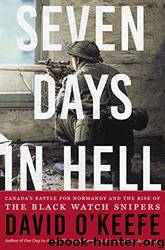Seven Days in Hell by David O'Keefe

Author:David O'Keefe [O'Keefe, David]
Language: eng
Format: epub
Publisher: HarperCollins Canada
Published: 2019-09-17T00:00:00+00:00
9
The Four Horsemen, Act II: The Ridge
It was perfectly clear that the attack should have been called off at a very early stage in the morning. Instead of that, the Corps Commander was pressing the Divisional Commander, and he was pressing us to get on with an attack which we knew was almost hopeless [and] under these circumstances, one does not quit. You do as much as you possibly can and hope that someone will see the light and give you some relief.
—BRIGADIER WILLIAM J. MEGILL
BY THE TIME BRIGADIER WILLIAM J. MEGILL SUMMONED Major Phillip Griffin to rendezvous with him in St. Martin, the acting Black Watch CO had accomplished a near-Herculean task under the most trying of circumstances. Neither the brigadier nor the division commander had demonstrated a firm grip on the unfolding situation during the night, and by default it fell to Griffin. Plagued by harassing fire, the young major had less than two hours to regroup his strung-out battalion, rearrange the timings for both the artillery and tanks, send out patrols, gather intelligence, evacuate prisoners and embark upon the clearance of Shell Alley to provide a solid base should the attack up Verrières continue.
In addition, despite Megill’s assertion that the guns of the 5th Field Regiment had plastered centres of German resistance along the ridge, pockets still chirped and Griffin reached out to the 1st Hussars, whose tanks had just arrived in the orchard to the north of St. Martin, to give the Black Watch some much-needed breathing room.
Major Walter Harris promptly responded, and his squadron of Shermans laid a sheet of high-explosive shells and machine-gun fire on the collection of knocked-out panzers, strung along the crest, that were suspected of housing German machine guns, camouflaged snipers and observation posts.
During this respite, Griffin did his best to clarify the confusing situation by dispatching a series of reconnaissance patrols to establish the whereabouts of the Calgary Highlanders in May and deal with reports of snipers operating near the church that had come to light in the wake of Duffield and Benson’s patrol. With that done, he still had one large thorn that remained firmly embedded in his side: the factory area adjacent to the Black Watch form-up point, which continued to be a beehive of German activity.1
From his slit near the church, Bruce Ducat could see Germans moving in plain sight, darting in and out of the structure, shuffling boxes of what looked like ammunition into place. None of them had paid serious attention to the Black Watch, but that would change once the rifle companies approached the area. Worried that enemy machine guns hidden in the structure would bring down heavy fire on the flank or rear of his battalion as they advanced, Griffin called upon Lieutenant Emile Michon and his under-strength company from the Calgary Highlanders to pacify the area.2
At first, Michon wilfully undertook the task, but after he “went forward on a recce,” he discovered “very heavy machine gun fire” emanating from the factory area
Download
This site does not store any files on its server. We only index and link to content provided by other sites. Please contact the content providers to delete copyright contents if any and email us, we'll remove relevant links or contents immediately.
| Africa | Americas |
| Arctic & Antarctica | Asia |
| Australia & Oceania | Europe |
| Middle East | Russia |
| United States | World |
| Ancient Civilizations | Military |
| Historical Study & Educational Resources |
The Guns of August by Barbara Wertheim Tuchman(850)
Uniforms of the German Solider by Alejandro M. de Quesada(813)
A World Undone by G. J. Meyer(801)
The Treaty of Versailles by Michael S. Neiberg(755)
I by Anonymous(745)
Catastrophe 1914: Europe Goes to War by Max Hastings(740)
The-Odyssey by Unknown(726)
The Ghost Ships of Archangel by William Geroux(690)
They Called it Passchendaele by Lyn Macdonald(656)
1914-1918: The History of the First World War by David Stevenson(627)
The Oxford Illustrated History of the First World War by Hew Strachan(611)
8.4 by Peter Hernon(608)
Goodbye to All That (Penguin Modern Classics)(590)
August 1914 by Bruno Cabanes(574)
First World War For Dummies by Seán Lang(563)
Seven Pillars of Wisdom : A Triumph (9780804170826) by Lawrence T. E(562)
Animals In War by Jilly Cooper(555)
Russia Against Napoleon: The True Story of the Campaigns of War and Peace by Dominic Lieven(555)
Defending Gallipoli by Harvey Broadbent(551)
